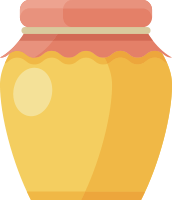What do beekeepers do during winter?
Added by Kent Pegorsch on
As I write this blog my honeybees are in California finishing up on almond pollination. Soon they will be back to Wisconsin.
So while I miss my bees, I am busy in the honey house preparing for the 2019 honey season. Part of that preparation is for the boxes that will go on my colonies to produce comb honey this summer. These boxes need to be setup so that I can cut the honeycomb from the box. Most of my boxes have the honey spun from the combs so that we can reuse the combs for several years. When harvesting comb honey, I cut the honeycomb from the wooden frame that holds the comb.
First, a little background on the beehive. in the mid 1800's, Reverend Langstroth of Dayton, Ohio was credited with the beehive design that used the "bee space". The bee space concept states that in any space larger than 3/8", honeybees will build comb to bridge other combs. In the Langstroth hive, the combs are fixed in moveable wooden frames that allow their removal for inspection, harvest and reuse. This is possible because the combs are placed approximately 3/8" apart. By doing this, the bees do not connect them together with bridge comb and the combs can easily be removed.
Here is a photo of a comb honey super with removable frames.
When I harvest liquid honey, I spin the honey from the combs and reuse the combs. For comb honey, I cut the honeycomb from the wooden frame. Here is a perfect frame of comb honey that I will harvest.
Here are the harvested sections of comb honey.
To prepare the boxes for comb honey, I install a thin wax foundation in each wooden frame.
This foundation provides the bees with a starting point to built nice uniform combs.
I lay the foundation in the frame and staple a wedge to hold it in place until the bees can build the comb in the frame.
Here is a completed frame.
Very few beekeepers produce comb honey because it is very labor intensive. It is also very difficult to get the honeybees to build and fill nice straight combs. After adding the boxes to the hive, I spend a lot of time inspecting frames to insure a beautiful honeycomb.
I paint the comb honey boxes yellow so that when I arrive at a bee yard, I can immediately see where they are. The yellow boxes contrast with the typical white boxes that I use.
In this photo of one of my bee yards, the yellow comb honey boxes are easily spotted

If you have never tried comb honey, you must! It is the best tasting honey because the cells have never been opened until you crush them to spread them on your toast or simply take a spoonful of honeycomb. All of the aroma and flavor is then released. I produce a lot of comb so that I can be sure that I always have some available in our store. That way, customers can buy it all year long. It is my favorite product to produce!


